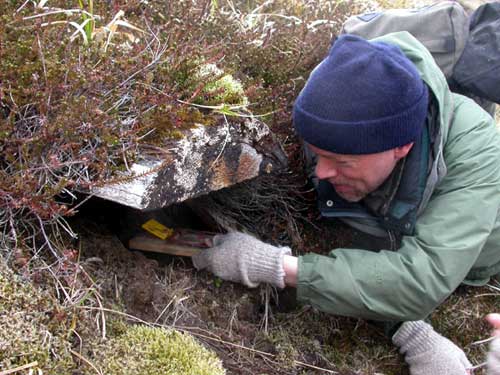 by Ned Rozell June 26, 2004
"There's fresh sign here," he said, sweeping away rye grass to expose dirt pressed down by the passage of many tiny feet. He hoped to catch a few rats and take tissue samples as part of a mission to learn as much as possible about how rats are affecting seabirds in the Aleutians.  Photo by Ned Rozell
About 25 miles long, 10 miles wide, and closer to Russia than to Anchorage, Kiska is one of the two places in America the Japanese occupied during World War II (the other being Attu, the farthest west island in the Aleutian chain). Along with rusting anti-aircraft guns and two broken ships in the harbor, the island is home to another relic of war-the rat. Norway rats were not present on the island during wildlife surveys performed by biologists before the war, but they were abundant after, having jumped from warships to wharfs built by the Japanese, and later American and Canadian soldiers. The rats have thrived on Kiska, in part by feeding on three species of auklets, small seabirds that spend the winter on the high seas but return every spring to Kiska to nest in the crevices of a lava dome that rose from the ocean in the 1960s. The auklet colony at Kiska is one of the wonders of the bird world, with birds returning in chattering groups that look from afar like swirls of pepper above the ocean. As the birds return each summer night, they scent the air with a mysterious wisp of tangerine given off by their bodies, and they darken portions of the sky with their sheer numbers. Jones said no one has come up with a method to count this many birds. "Counting auklets is like counting snowflakes," Jones said. "Kiska might have three-to-six million auklets, the majority of which are least auklets." Kiska also has rats, which scurry through the cavities in lava in which auklets prefer to nest. The rats eat countless eggs and also feed on the brains of nestlings and the adults, which are half the rats' size. After rough winters in which they sometimes resort to cannibalism, the rats often cache their springtime bounty without returning for it. "In one cache, we found 115 least auklets, four fork-tailed storm-petrels, one adult female rat, and her nine rat pups," Jones said. In the first two years of his study on Kiska, Jones found that the rates at which auklet eggs endured to become successful fledglings were 12 percent and 10 percent, the lowest ever recorded for the species. Last year, his research group recorded a breeding success rate of 50 percent, and he saw less rats. "Even though they did OK last year, the auklets have to do better than that on a regular basis to maintain their population," Jones said. Jones said he hoped the U.S. Fish and Wildlife Service, the sponsors of his study and his hosts on the research ship Tiglax, would eventually rid the island of rats the way the service has eliminated arctic foxes from some of the 2,500 islands in the Alaska Maritime National Wildlife Refuge. "These rats are actually beautiful animals, but they do not belong on the island," he said. "The Aleutians are a special reservoir of biodiversity, and leaving rats on even one island is unacceptable, because of the possibility of them getting on other islands in the future."
This column is provided as
a public service by the Geophysical Institute, University of
Alaska Fairbanks, in cooperation with the UAF research community.
Ned Rozell is a science writer at the institute. E-mail Ned Rozell
at nrozell@gi.alaska.edu
|